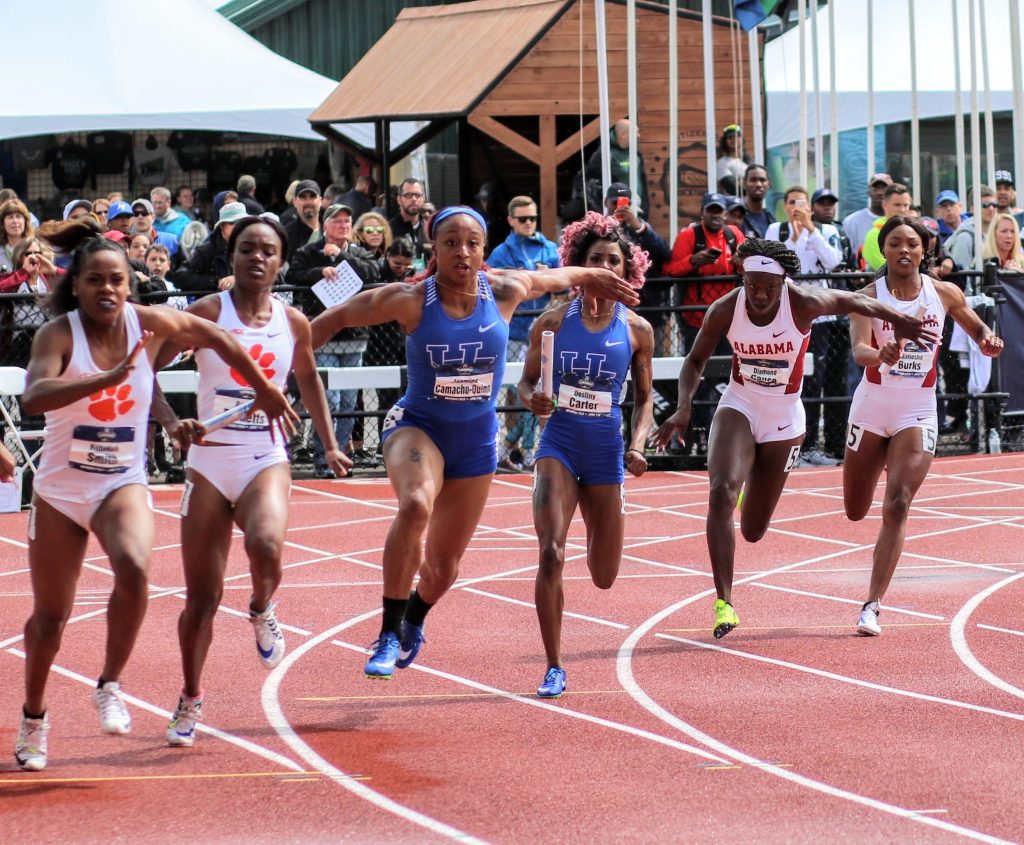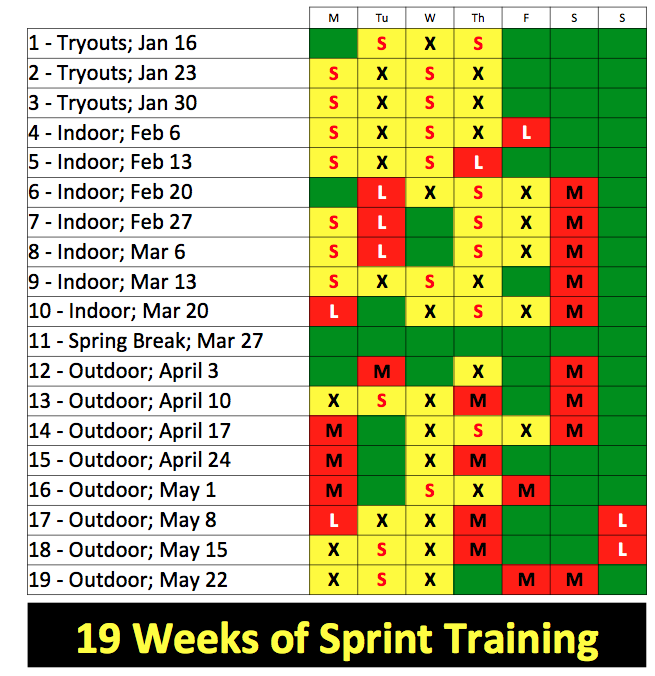
A Simple Plan
First-time track coach? First-time sprint coach?
How do you “Feed the Cats”? Does this program work with girls?
Last week I received a message from Sara Baker, the new girl’s track coach at Marion H.S. in Southern Illinois. Sara ran middle distance for Fox Lake Grant and later at McKendree. Sara married Marion’s Eli Baker. Eli placed 12th in the 1600 and 3200 at the 2001 IHSA State Meet and later excelled for the Salukis of SIU. Eli Baker is the head boy’s track coach at Marion. Eli and Sara Baker are king and queen of track & field in Marion.
“I’ve been working at getting the girl’s program rebuilt and restructured. I’m taking on a new challenge, coaching our girl sprinters and leaving the girl distance runners to Eli. I have a lot to learn and would love to hear your advice on good workouts and if there are any differences when it comes to working with girls. I feel like there are a million things I need to start doing but I also know many of the 45 girls I’ve recruited have little to no experience. I also know I need to start small.” – Sara Baker
My answer follows …
“Yes, *Feed the Cats* works for girls, maybe even better than boys! Keep your sprint practice ridiculously brief. Time your sprinters in short sprints. Record, Rank, and Publish. Don’t sprint more than three times a week. One of those days needs to be a lactate workout. Try the 23-second drill. The other days need to be a break from sprinting. We call those alternative days, *X-Factor*. Keep distance kids (800m and above) separate from sprinters. Allow jump training to take the place of a speed day or do jumps in addition to sprinting (remember, sprint workouts are ridiculously short, I call it *microdosing*). Exact same with hurdling.”
You can stop reading now. The paragraph above is “A Simple Plan”. Leave your throwers to the throws coach and your distance runners to your distance coach. If you are coaching the team alone, like I did in Franklin, TN (2004-2006), send your distance kids on a three mile run. When they return, tell them to stretch until sprint practice is over. Then run intervals at race pace varying rest. Alternate hard and easy workouts. Tell your throwers to go throw and have them video each other (I had 54’9″ & 163’6″ thrower using this approach). Done. “A Simple Plan”.
Disclaimer: My proof-reader, my son Alec, was critical of my article because of over-generalization and over-simplification, but this was never meant to be my *book* on Feed the Cats. This article is *A Simple Plan*. I want to reiterate that everything must be done with low-dosage in mind. Ten times more problems come from over-training than under-training. Maybe 100x more.
Details of Speed Day
Don’t warm up. Don’t stretch. We do ten speed drills – fast march, skips, high knees, butt kicks, 5 box jumps, bounding, prime times x2, butt-kick and reach x2, and one falling start into a full sprint. That’s it. The following video is old, one part of it was done on a 70-degree Christmas Day on Harrisburg High School’s football field. The star of the video, Cole Perkins, went on to win the 300 Intermediates (38.87) and ran on a 3:18.3 4×4 team, pretty fast for a small poverty-ridden coal-mining town smack-dab in the middle of Bible-Belt Trumpland. (People get so pissed when I interject politics!) The other guy from 2003, videoed in Harrisburg’s beautiful gym, is Ryan Garnett (LJ 22’6″, TJ 44’6″, 21.93 in 200, 49.1 lead-off 4×4). Anyway, the video below gives a good sampling of my speed drills. We presently do them much quicker, faster, and with more rhythm. I describe our approach as “caffeinated” (and there’s nothing wrong with caffeine and sprinting; my favorite energy drink is Celsius). I strongly believe that sprinting is much more NEURO than MUSCULAR. During drills, teach mechanics. “Cross the Hips” (hands), “Big in the Front” (knee up with foot under knee), and “Run Tall” (I tell 5’6″ Marcellus Moore to run like he’s 5’8″).
“Success has less to do with hoping and praying and strategizing than with diligently doing the right things, the right way, over and over and over.” – from The Motivation Myth by Jeff Haden.
When speed drills are finished, time three short sprints. If you only have a stopwatch, time three 40s (boys hurdle marks are 10 yards apart). Average the best two, then *Record-Rank-Publish* on a Google Doc and tweet it to the world. Attach a picture of the fastest kid or the most improved kid or a group pic of the PRs. Slow motion videos are cool too. The shortest fly you can time with a stopwatch would probably be 30 yards. Have a trustworthy slow kid drop a hand at the start of they fly. Use a hurdle at the start and end of the fly as a visual marker. Like the 40s, average the best two and *Record-Rank-Publish*. If you are too chicken to post times on Twitter, post them on a top-secret bulletin board.
Timing sprints allow kids to break records in practice. See how many things get quantified in practices at Plainfield North: Practice Rankings.
“There’s only one recipe for gaining motivation: success. Specifically, the dopamine hits we get when we observe ourselves making progress.” – from The Motivation Myth by Jeff Haden.
Dopamine is the food of cats. Dopamine creates reckless confidence and fuels winning.
“With increased dopamine, we experience an increased excitatory effect on our motor neurons and an accelerated velocity of limb movement. Not the worst thing in the world for sprinters.” – Pat Davidson.
Remember, jumps practice can take the place of speed work. Our jumps coach, Dr. Brian Damhoff, usually does jump work in addition to speed work. Brian tries to work with each jump one day per week (HJ one day, LJ one day, TJ one day). I also encourage our specialty coaches to “make appointments” with kids on weekends. We don’t practice on non-school days. Jump as little as possible. Keep jumpers as fresh as possible. Jumpers who will never run the 200 and 400 should never do lactate workouts. Of course, none of our sprinters and jumpers do aerobic workouts. EVER.
X-Factor Days
Here is your first X-Factor workout.
♦ Wickets (10-12 minutes)
♦ Hurdle Mobility (10-12 minutes)
♦ Depth Jumps and Assisted Plyos (10-12 minutes)
You can do anything on X-Factor days as long as it’s alactic and not spiked-up sprinting and timing. Remember, on X-Factor days, never do lactate work (10+ seconds of intensity that makes you dizzy) and never do aerobic work (long slow work done at a pace where athletes can talk to each other during the workout).
Everyone wants to know about wickets. I use wood slats and pretend they are mini-hurdles. No one ever knocks over my mini-hurdles! We use a 15-20 meter run-up and SPRINT. Hurdles are six feet apart. We are not working on an acceleration stride pattern, we are working on max-speed mechanics. We do strange things with our arms in order inject some chaos into the equation. In other words, we take a stable skill and destabilize it to encourage adaptation. We are also working on the “stiffness” of our core and forcing our glute meds into action. Recently I was training an NFL running back and had him sprint the wickets with ten-pound dumbbells overhead – try it sometime. (When hands are overhead, they must be straight up and high as possible – “hands to the sky”). Try seven-foot wickets and tell your kids to SPRINT without REACHING. Try five foot wickets and tell your kids to be fast with the ups and downs (like pistons). Try one line of five feet and one line of seven. Chaos!
Keep everything less than five seconds and full intensity (alactic training). Our X-Factor workouts begin with four speed drills: fast march, skips, high knees, and prime times. All four are done with hands to the sky.
It’s not a bad idea to have all your kids go through low-impact hurdle drills. Here is a video made by my son, Alec Holler. Remember, anything can be X-Factor.
You can also put single leg bounding and triple jump drills into your X-Factor days. Why not give all your athletes a chance to become a hurdler or triple jumper. In my experience, kids that get good at triple jumping and/or hurdling become more athletic at everything. Sometimes we measure vertical jump. Sometimes we measure ten bounds. We always *Record, Rank, Publish* whenever we measure.
Coordination, rhythm, force absorption, and balance are also points of emphasis on X-Factor days.
Remember, keep your X-Factor days ridiculously SHORT. You didn’t sign up to be the after-school day care coordinator. Practice 45 minutes and turn the kids loose. And, no, WE DON’T DO A “COOL-DOWN”. However, most of my kids do something after practice. Some play basketball. All of my football players go to the weight room. Every kid feels better after a workout than they did before their workout (with the exception of our lactate workouts).
Lactate Workouts
Never do a lactate workout more than twice in a week. Meets count as lactate workouts. Lactate workouts (and meets) take the place of a sprint day too.
Boys do the 23-second drill outside (measure how far you can run in 23 seconds, shooting for 200m, solo, then repeat in 8-10 minutes). We do a 24-second drill on our 179m indoor track (makes 200m as a goal possible). I’ve heard of girl’s coaches doing the 27-second drill (chasing 200m).
If you haven’t read this, better check it out. The Survival of King Mithridates.
The Recipe

I made the practice plan above as a slide for a clinic presentation last year. I had never looked at my training from a full-season perspective. I have always planned week by week with generalized parameters in mind. Last year’s plan had to be tweaked due weather, meet cancellations, and anything else that was unexpected. It’s interesting the percentage breakdown by colors: 40% yellow, 20% red, 40% green. Twice as many OFF-DAYS (green) as lactate + meet days (red) is a good indicator that I prioritize rest. I might be the only coach in America to say for the last 20 years, “Practice is over-rated”.
“The wisdom of life consists in the elimination of non-essentials.” – Lin Yutang
Im a believer in AMPLIFICATON by SIMPLIFICATION.
Below are some general parameters for practice weeks.
Open Week – No Meets
Monday – Speed
Tuesday – X
Wednesday – Speed
Thursday – X
Friday – Lactate
Saturday Meet
Monday – Lactate
Tuesday – Sprint Holiday or X
Wednesday – Speed
Thursday – X
Friday – Sprint Holiday or Handoffs
Saturday – Meet
Tuesday-Saturday Meet
Monday – X
Tuesday – Meet
Wednesday – Sprint Holiday or X
Thursday – Speed
Friday – X, Handoffs
Saturday – Meet
Tuesday-Friday Meet
Monday – X
Tuesday – Meet
Wednesday – Sprint Holiday or X
Thursday – X, Handoffs
Friday – Meet
(Sunday would be a perfect sprint day)
“But if we have meets on Tuesday and Friday, we never really practice!”
No shit! We schedule like this in April because weather will often cause multiple cancelations. By the way, always be the first coach voting to cancel a meet. Track is a tough sell to kids. Track in 40-degree pouring rain is stupid. Cancel and get a day of rest. Rest is more important than any workout you’ll ever do! April track and field in Illinois is simply survival … survival until May.
“But when will we get faster if all we are doing is recovering from meets?”
Yep. This is a problem. You won’t get faster running two meets per week. If you are not careful, your kids will get slower. Even worse, your kids may get injured. This is why you can’t go “Clyde Hart” on your your kids all winter. You can’t run laps in the hallways or miles on the frozen tundra. Sprinting (or at the very least, acceleration and doing lots of plyos) must be done all winter. In matter of fact, sprinting must be done all summer, all fall, AND all winter because pure speed doesn’t improve during the season. My sprinters get faster at the 100, 200, and 400 but they get slower in the 10m fly. Lactate work does NOT build speed. Anything you do for more than five seconds will NOT improve speed.
General Rules
Keep lactate workouts away from meets and sprint workouts (48-hour hangover).
Here is your weekly algorithm: Speed + Lactate + Meets = 3
If you have three meets in a week, God forbid, you get NO speed workouts and no lactate workouts. Never do aerobic work with sprinters, EVER. This method of training will train ALL sprinters – 100, 200, 400, 110 HH, 300 INT, 4×1, 4×2, 4×4, jumpers, and vaulters. This method of training allows you to *Sprint as fast as possible, as often as possible, while staying as fresh as possible*. Tired is not the goal, tired is the enemy.
This program, Feed the Cats, will increase your sprinter’s love of track & field. Your fast-twitch athletes will be happier and healthier. Happy sprinters are your best recruiters.
One last thing, Feed the Cats will not work unless you *sell it* to kids. Like everything else, reluctant participants get nothing out of the activity. The buy-in is imperative. As a coach, you must take the leap of faith here. I call it *Drinking the Kool Aid*.
By the way, don’t ever say something ignorant like “Our school doesn’t have any cats.” or “Tony Holler is working with a different clientele.” As Marcellus Moore told me in class recently, “Everyone can be a cat if they are trained right.” Pretty smart for a 15 year-old.
Speed grows like a tree. Plant now. Water it three times a week.
+++

Tony Holler (630) 849-8294, tony.holler@yahoo.com
+++
Feed the Cats Track Bundle – 50% off the Feed the Cats Certification Track Package
Feed the Cats Football Bundle – 50% off the Feed the Cats Football Package
Want all the Feed the Cats stuff (track, football, speed)? Get them all for only $255. Click here.


Gold straight Gold!!!
How do you feed the cats that hurlde?
May be an article devoted to this question this week.
Stupid question(s) coming, but I apologize because I want to be sure. When running the 40s are you timing the 40? When do you start the 10m fly? Start or last 10? Once again I apologize for the dumb questions. I am still learning.
Josh, I time the final 10m of the 40 YARD dash using Freelap cones. The 40 is hand-timed (faster times, 20 years of comparative data). The 40 is the average of that guy’s best two times of the day. We run 3. The 40 forces my kids to work on acceleration. The 10 gives me the best metric of speed you can get.
Thank you very much for the help Coach.